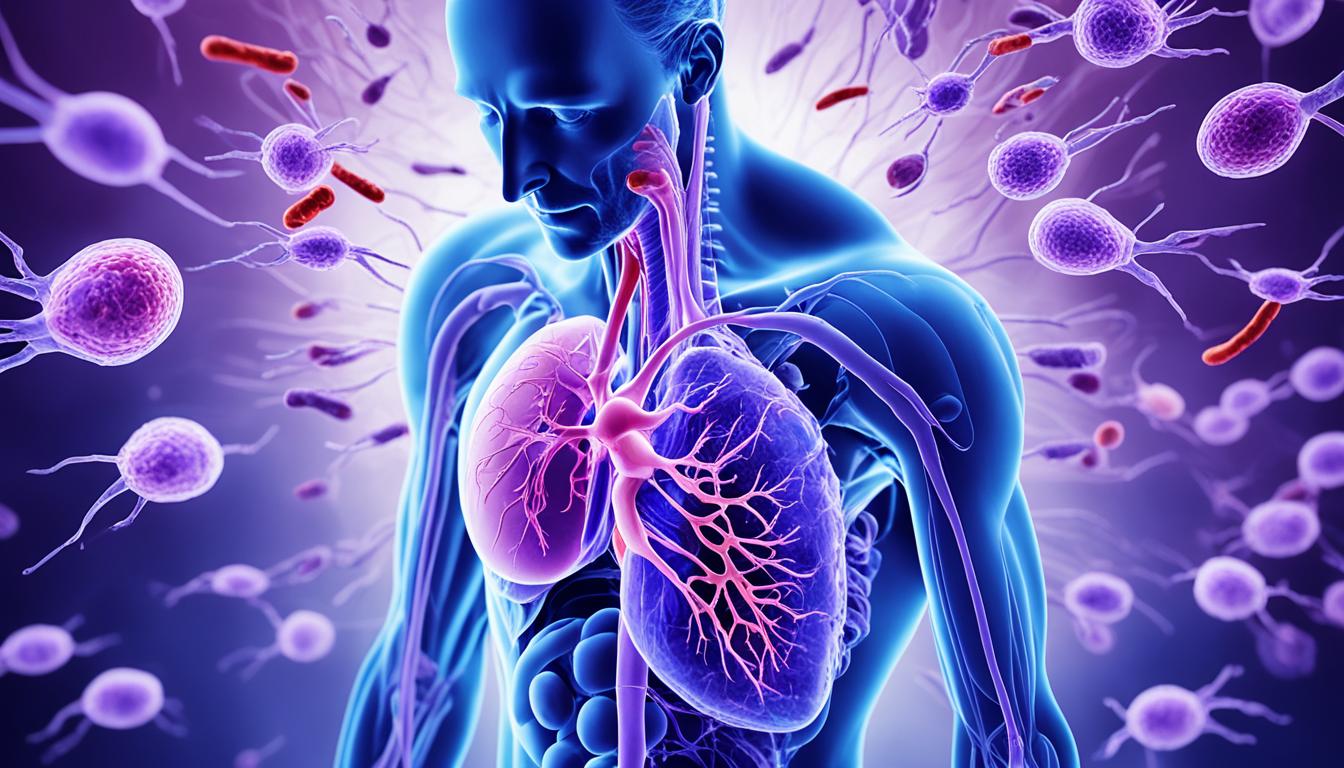Chagas disease is caused by the parasite Trypanosoma cruzi. It’s mainly found in Latin America. Yet, global travel has spread it worldwide. This illness can cause a severe heart condition. Symptoms include heart failure, arrhythmia, and clot formation.
Doctors diagnose Chagas disease using lab tests like serological assays and PCR. Unfortunately, a silver bullet cure doesn’t yet exist. But, there’s hope in stem cell therapy. This treatment shows potential by helping the heart heal. It reduces inflammation and scarring, making the heart work better in those with Chagas disease.
Key Takeaways:
- Chagas disease is a neglected tropical disease caused by the parasite Trypanosoma cruzi.
- Chagas disease can lead to chronic cardiomyopathy, resulting in heart failure, arrhythmias, and thromboembolism.
- The diagnosis of Chagas disease is made through laboratory tests like serological assays and PCR.
- Currently, there is no effective treatment for Chagas disease, but research is being conducted on the use of stem cell therapy.
- Stem cell transplantation aims to reduce inflammation and fibrosis in the heart, improving cardiac function in patients with chronic Chagas disease.
Chagas Cardiomyopathy and Its Mechanisms
Chagas cardiomyopathy is the severe form of Chagas disease, affecting the heart. It involves chronic inflammation and scarring. This results from issues like heart failure, inflammation, fibrosis, and an autoimmune reaction.
The disease is caused by the Trypanosoma cruzi parasite, leading to heart damage and inflammation. In its chronic phase, the parasite is less active but inflammation remains high, especially in the heart. This inflammation sets off a chain of events, causing the heart to change shape, weaken, and grow larger.
Over time, the heart’s healthy tissues are replaced by scar-like fibrotic tissue. This change makes the heart less effective at pumping blood. The heart’s structure is altered by the fibrotic tissue, which hinders its function.
Inflammation is key in Chagas cardiomyopathy. It is prompted by the parasite and causes the body to release harmful molecules and attract immune cells to the heart. This inflammation adds to the fibrosis and continues to harm the heart.
Chagas cardiomyopathy also involves an autoimmune problem. Here, the immune system mistakenly attacks heart cells. This causes more inflammation and scarring, worsening the heart’s condition.
Key Factors Contributing to Chagas Cardiomyopathy:
- Heart failure: The chronic inflammation and fibrosis in the heart decrease its blood-pumping ability, leading to heart failure.
- Inflammation: The persistent inflammation from the parasite damages the heart’s tissues and causes fibrosis.
- Fibrosis: High amounts of collagen and other materials disrupt the heart’s function.
- Autoimmune response: Immune system attacks on healthy heart cells worsen the problem by causing more inflammation and fibrosis.
Knowing the causes of Chagas cardiomyopathy is crucial. This knowledge helps in creating better treatments and stopping the disease from getting worse.
| Prognostic Markers for Chagas Cardiomyopathy | |
|---|---|
| 1. NYHA functional class | Staging of heart failure severity based on the patient’s symptoms and exercise tolerance. |
| 2. Left ventricular systolic function | Testing the heart’s ability to pump blood normally. |
| 3. Presence of nonsustained ventricular tachycardia | Signs of an irregular heart rhythm with short, rapid episodes. |
Stem Cell Therapy for Chagas Cardiomyopathy – Current Research and Future Directions
Stem cell therapy offers new hope to treat Chagas cardiomyopathy, a serious heart disease from Chagas disease. Studies on animals are showing good signs. Transplanting bone marrow cells helps the heart by cutting down on swelling and scarring. It even makes the right side of the heart smaller again in sick mice.
Now, human trials are happening to see if bone marrow from the patient can help in the end stages of this heart disease. So far, the results are looking up. Patients with stem cell treatment show better heart function. This gives a light of hope for people with Chagas cardiomyopathy, suggesting their heart health and life quality may get better.
But, we still need to learn more. We must figure out the best cells to use, how to put them in, and what happens in the long run. More studies and trials are going on to answer these big questions about stem cell therapy. The goal is to make stem cell therapy a reliable and powerful way to fight Chagas cardiomyopathy.

